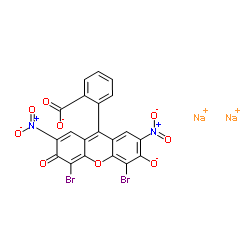Eosine I Bluish

Eosine I Bluish structure
|
Common Name | Eosine I Bluish | ||
|---|---|---|---|---|
| CAS Number | 548-24-3 | Molecular Weight | 624.057 | |
| Density | N/A | Boiling Point | 694.1ºC at 760 mmHg | |
| Molecular Formula | C20H6Br2N2Na2O9 | Melting Point | 275ºC (dec.)(lit.) | |
| MSDS | Chinese USA | Flash Point | 373.6ºC | |
|
Modulation of collagen by addition of Hofmeister salts.
Int. J. Biol. Macromol. 79 , 518-26, (2015) Collagen can be modified by addition of chaotropic or kosmotropic salts of the reversed Hofmeister series. Hence, telopeptide-poor collagen type I was suspended in H2SO4 (pH 2) and 0.05-0.5 M KCl and KNO3 (chaotropes), as well as KI and KSCN (kosmotropes). Rh... |
|
|
How Romanowsky stains work and why they remain valuable - including a proposed universal Romanowsky staining mechanism and a rational troubleshooting scheme.
Biotech. Histochem. 86(1) , 36-51, (2011) An introduction to the nomenclature and concept of "Romanowsky stains" is followed by a brief account of the dyes involved and especially the crucial role of azure B and of the impurity of most commercial dye lots. Technical features of standardized and tradi... |
|
|
Functional characterization of the domains of the bovine binder of SPerm 5 (BSP5) protein.
Reprod. Biol. Endocrinol. 13 , 64, (2015) Bovine BSP5 is a multifunctional protein primarily involved in sperm capacitation. BSP5 consists of long N-terminal part followed by two similar and highly conserved fibronectin type II domains designated A and B.In order to assess the role of these domains i... |
|
|
In vivo pharmacology and antidiarrheal efficacy of a thiazolidinone CFTR inhibitor in rodents.
J. Microbiol. Methods 116 , 1-7, (2015) A small-molecule inhibitor of the cystic fibrosis transmembrane conductance regulator (CFTR), 3-[(3-trifluoromethyl)phenyl]-5-[(4-carboxyphenyl)methylene]-2-thioxo-4-thiazolidinone (CFTR(inh)-172), reduces enterotoxin-induced intestinal fluid secretion in rod... |
|
|
Prevention of phenytoin-induced gingival overgrowth by lovastatin in mice.
Am. J. Pathol. 185 , 1588-99, (2015) Drug-induced gingival overgrowth is caused by the antiseizure medication phenytoin, calcium channel blockers, and ciclosporin. Characteristics of these drug-induced gingival overgrowth lesions differ. We evaluate the ability of a mouse model to mimic human ph... |
|
|
SOD3 reduces inflammatory cell migration by regulating adhesion molecule and cytokine expression.
PLoS ONE 4(6) , e5786, (2009) Inflammatory cell migration characteristic of ischemic damages has a dual role providing the tissue with factors needed for tissue injury recovery simultaneously causing deleterious development depending on the quality and the quantity of infiltrated cells. E... |
|
|
Effect of (-)-epigallocatechin-3-gallate on maintaining the periodontal ligament cell viability of avulsed teeth: a preliminary study.
J. Periodontal Implant Sci. 41(1) , 10-6, (2011) Avulsed tooth can be completely recovered, if sound periodontal ligament (PDL) of tooth is maintained. Although a lot of storage solutions have been explored for the better storage of avulsed tooth, there is a shortcoming that the preservation time is much sh... |
|
|
Estimation of submicrogram quantities of protein using the dye eosin Y.
J. Biochem. Biophys. Methods 42(3) , 125-32, (2000) Eosin B is used to estimate proteins above 1 microg/ml concentration [Waheed AA, Gupta, PD. Anal. Biochem. 1996:233:249-256; Waheed AA, Gupta PD. J. Biochem. Biophys. Meth. 1996;33:187-196]. In the present report we describe a method for estimating submicrogr... |
|
|
Application of an eosin B dye method for estimating a wide range of proteins.
J. Biochem. Biophys. Methods 33(3) , 187-96, (1996) We describe a detailed procedure for estimating a wide range of proteins by the eosin B dye method. At acidic pH, eosin B binds to proteins and absorption of the protein-dye complex at 536-544 nm is proportional to the concentration of the proteins. Inorganic... |
|
|
A molecular docking strategy identifies Eosin B as a non-active site inhibitor of protozoal bifunctional thymidylate synthase-dihydrofolate reductase.
J. Biol. Chem. 278(16) , 14092-100, (2003) Protozoal parasites are unusual in that their thymidylate synthase (TS) and dihydrofolate reductase (DHFR) enzymes exist on a single polypeptide. In an effort to probe the possibility of substrate channeling between the TS and DHFR active sites and to identif... |